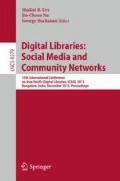Abstract
Despite being a topic of growing interest in social learning theory, vicarious learning has not been well-studied so far in digital library related tasks. In this paper, we address a novel ranking problem in research collaboration networks, which focuses on the role of vicarious learner. We introduce a topology-driven vicarious learning definition and propose the first centrality method for ranking vicarious learners. Results obtained on DBLP networks support the significance and uniqueness of the proposed approach.
Access this chapter
Tax calculation will be finalised at checkout
Purchases are for personal use only
Preview
Unable to display preview. Download preview PDF.
References
Bandura, A.: Social foundations of thought and action: A social cognitive theory. Prentice Hall, Englewood Cliffs (1986)
Brin, S., Page, L.: The anatomy of a large-scale hypertextual Web search engine. Computer Networks and ISDN Systems 30(1-7), 107–117 (1998)
Deng, H., Han, J., Lyu, M.R., King, I.: Modeling and exploiting heterogeneous bibliographic networks for expertise ranking. In: Proc. Int. Joint Conf. on Digital Libraries (JCDL), pp. 71–80 (2012)
Ding, Y., Yan, E., Frazho, A.R., Caverlee, J.: Pagerank for ranking authors in co-citation networks. Journal of the American Society for Information Science and Technology 60(11), 2229–2243 (2009)
Fagin, R., Kumar, R., Sivakumar, D.: Comparing Top k Lists. SIAM Journal on Discrete Mathematics 17(1), 134–160 (2003)
Das Gollapalli, S., Mitra, P., Lee Giles, C.: Ranking authors in digital libraries. In: Proc. Int. Joint Conf. on Digital Libraries (JCDL), pp. 251–254 (2011)
Li, X.-L., Foo, C.S., Tew, K.L., Ng, S.-K.: Searching for Rising Stars in Bibliography Networks. In: Zhou, X., Yokota, H., Deng, K., Liu, Q. (eds.) DASFAA 2009. LNCS, vol. 5463, pp. 288–292. Springer, Heidelberg (2009)
Liu, X., Bollen, J., Nelson, M.L., Van de Sompel, H.: Co-authorship networks in the digital library research community. Information Processing and Management 41, 1462–1480 (2005)
Ma, N., Guan, J., Zhao, Y.: Bringing PageRank to the citation analysis. Information Processing and Management 44(2), 800–810 (2008)
Sharma, M., Urs, S.R.: Network of Scholarship: Uncovering the Structure of Digital Library Author Community. In: Buchanan, G., Masoodian, M., Cunningham, S.J. (eds.) ICADL 2008. LNCS, vol. 5362, pp. 363–366. Springer, Heidelberg (2008)
Sun, Y., Barber, R., Gupta, M., Aggarwal, C.C., Han, J.: Co-author Relationship Prediction in Heterogeneous Bibliographic Networks. In: Proc. Int. Conf. on Advances in Social Networks Analysis and Mining (ASONAM), pp. 121–128 (2011)
Tagarelli, A., Interdonato, R.: “Who’s out there?” Identifying and Ranking Lurkers in Social Networks. In: Proc. Int. Conf. on Advances in Social Networks Analysis and Mining (ASONAM), pp. 215–222 (2013)
Tsatsaronis, G., Varlamis, I., Torge, S., Reimann, M., Nørvåg, K., Schroeder, M., Zschunke, M.: How to Become a Group Leader? or Modeling Author Types Based on Graph Mining. In: Gradmann, S., Borri, F., Meghini, C., Schuldt, H. (eds.) TPDL 2011. LNCS, vol. 6966, pp. 15–26. Springer, Heidelberg (2011)
Wang, C., Han, J., Jia, Y., Tang, J., Zhang, D., Yu, Y., Guo, J.: Mining advisor-advisee relationships from research publication networks. In: Proc. ACM SIGKDD Int. Conf. on Knowledge Discovery and Data Mining (KDD), pp. 203–212 (2010)
Yan, E., Ding, Y.: Discovering author impact: A PageRank perspective. Information Processing and Management 47(1), 125–134 (2011)
Author information
Authors and Affiliations
Editor information
Editors and Affiliations
Rights and permissions
Copyright information
© 2013 Springer International Publishing Switzerland
About this paper
Cite this paper
Tagarelli, A., Interdonato, R. (2013). Ranking Vicarious Learners in Research Collaboration Networks. In: Urs, S.R., Na, JC., Buchanan, G. (eds) Digital Libraries: Social Media and Community Networks. ICADL 2013. Lecture Notes in Computer Science, vol 8279. Springer, Cham. https://doi.org/10.1007/978-3-319-03599-4_11
Download citation
DOI: https://doi.org/10.1007/978-3-319-03599-4_11
Publisher Name: Springer, Cham
Print ISBN: 978-3-319-03598-7
Online ISBN: 978-3-319-03599-4
eBook Packages: Computer ScienceComputer Science (R0)

